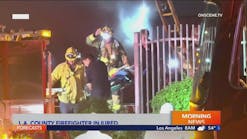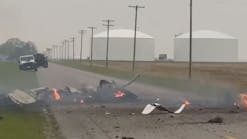The notion of a command team indicates that there is a shared responsibility for the proper and safe performance of our troops. The fact is that one of the roles that the ISO needs to play is that of challenging and confirming the incident commander's actions. This article will address this concept as well as describe just what a safety officer must do to be successful at this most critical role.
As the opening paragraph suggests, the ISO has to be included in the development and monitoring of the incident action plan. As a quick review, there are five elements that make-up the very important incident action plan (IAP). These components are strategy, tactics, and resources, risk management and estimated outcomes. Strategy is the broad approach to handle the situation.
A basic strategy might be to rescue the victim out of an overturned vehicle. The tactics to reach this broad goal would be to use a hydraulic tool to remove the roof and steering wheel. The resources are composed of the apparatus, equipment and personnel that are available to implement the tactics as well as what will be needed. Risk management is the on-going evaluation determining if the risk that we take are worth the benefits that we gain (sometimes called risk versus benefit analysis).
The simplest way to express the risk management process is by using three statements of risk analysis. First, "we will risk a lot to save a lot"; this usually looks like saving lives. Next, "we will risk a little to save a little", generally applied to property concerns. Finally, "we will take no risk for what is already lost". Sometimes the opportunity to help has passed before we can arrive on location. The risk management plan must be carries out using standard operating procedures, proper training techniques and using the incident management system (see January's Safety Officer Column - Part III).
The ISO must be in on the development of this plan. He/she should serve as the "bell weather" to make sure that the plan is sound from a safety and operations standpoint. In mature emergency medical and fire organizations, this process of checks and balances is viewed as a positive addition rather than a burden or weakness. Much like a jet liner pilot and the air traffic controller, there is an effort to always make the correct decisions regarding takeoffs and landings. If either person determines that a flaw exists in the flight plan, that person is obligated to fix the problem without delay. In simple terms, the IC and the ISO command team is a system of checks and balance designed to keep us safe.
Once the IAP is established, the safety officer monitors the plan for effectiveness and efficiency. The safety officer becomes another set of eyes and ears for the IC. The safety officer pays close attention to many concerns and activities at an emergency. The ISO is checking for unsafe acts, unsafe conditions and unsafe behaviors that could cause injury or death to the operating crews. For instance, is proper body substance isolation techniques being used during patient treatment or is a charge hose line properly placed when a hydraulic tool is being operated for vehicle extrication? By being trained, educated and experienced in all phases of the operations being performed, the ISO can be an effective observer. This may sound simple, but the truth is that it is a formidable task.
The person that takes on the role of ISO must be a very capable person. Keep in mind, some incidents, because of size or complexity will require more than one ISO. Most departments establishes an ISO and then provides him/her with the required number of assistant ISO's that are necessary to properly handle the job. A hazardous materials alarm or a train derailment with injuries would be good examples when more than one ISO is needed.
Maybe one of the ISO's most important duties is forecasting unsafe acts, conditions and behaviors, before they happen. By understanding the dynamics of the operations, the ISO should be able to predict what most likely will happen next. By knowing building construction features, the ISO could foresee a secondary collapse at an urban search and rescue scene. Another example would be for the ISO to expect and plan for a secondary explosive device at a terrorism-bombing incident. The ISO must always be observing the actions and situations in front of him/her as well as think about what will soon be happening.
One needs to consider that all most all EMS/fire/rescue personnel fatalities and injuries happen at highly predictable events. If we are killing or hurting our members at highly predictable events, we should be able to prevent these same casualties. Undoubtedly, there will be EMT's, firefighters and/or paramedics that read this paragraph and take exception to this notion. However, simply review the NIOSH or NFPA investigation reports to sadly realize that it is a true statement.
A few case studies would reveal that there were no indications of a future event that would unfold and hurt responders, these situations are few and far between. However, many more times than not, many preceding clues were present indicating looming disaster, but not heeded.
A couple of the case studies indicate that patient care was started on an interstate highway without any type of barriers or separations between the responders and the high-speed traffic. Not so unexpectedly, in the heat of battle our guys step out into the on-coming vehicles and get killed. It seems like building collapse signs and signals are frequently missed. A large city the fire department was called out to handle a major warehouse blaze. The fire units were at this call for an extended period of time. The building was fully involved and the fire was out of control. It was easy to determine that this burning structure was a very old building and not savable (risk nothing to save nothing should come to mind).
With all of these overt clues, a large number of firefighters attempted to make entry into the only part of the building that was not ablaze. Within a few minutes an "inward/outward" wall collapse occurred, killing one member and injuring many others. Neither case should have been a surprise to the IC or the ISO. The goal would have been to forecast the upcoming events and to prevent them from occurring.
To assist the incident safety officer balance all of these responsibilities, the use of a checklist should be incorporated. The checklist becomes a job aid to help ensure that every aspect of the incident get addressed from a safety standpoint. A good starting place for a checklist is as follows:
This list should be adapted to your local needs and conditions. Further, the authors consider this example list as being "under construction" or constantly being revised for improvement sake.
If we are going to reduce the number of injuries and fatalities that occur each year to our people, we must improve the capabilities of our safety officers. Consider building the "command team" process. This is not to take away authority or responsibility, but should only serve to improve decision and supervision. Remember that incidents should be directed by an incident action plan.
Typically, this is used as a guideline and not necessarily written out. At large scale situations; you may want to record the IAP on paper. Using a team approach coupled with a specific incident action plan should help make your operations safer and more effective. Incorporate the challenge and confirm process between the IC and the ISO at every major incident.
The ISO needs to be observing for unsafe acts, conditions and behaviors throughout the incident. Among the many items that the ISO must observe, pay attention to the details that might provide clues in predicting what might happen. Then take steps to put a preventive plan into effect before the problems present themselves. In some cases there may need to be assistant safety officers added to the command team based on the size or the complexity of the alarm.
Considering developing and using a safety officer checklist. This will help to make sure that all aspects of the incident are properly and completely considered. This responsibility is much too important to leave to memory or chance. The position of incident safety officer is probability the second most important role that is played out at an incident. There is a lot that goes into performing this job assignment well, but the "climb is worth the view". Until next time, be safe out there!





